Welcoming newborn kittens vs newborn puppies into your life is an exciting and heartwarming experience. These tiny, furry companions fill your home with love, curiosity, and joy from the moment they arrive. However, caring for newborn pets also comes with great responsibility. While both kittens and puppies are undeniably adorable, they have unique needs and challenges during their early days that every pet owner should understand.
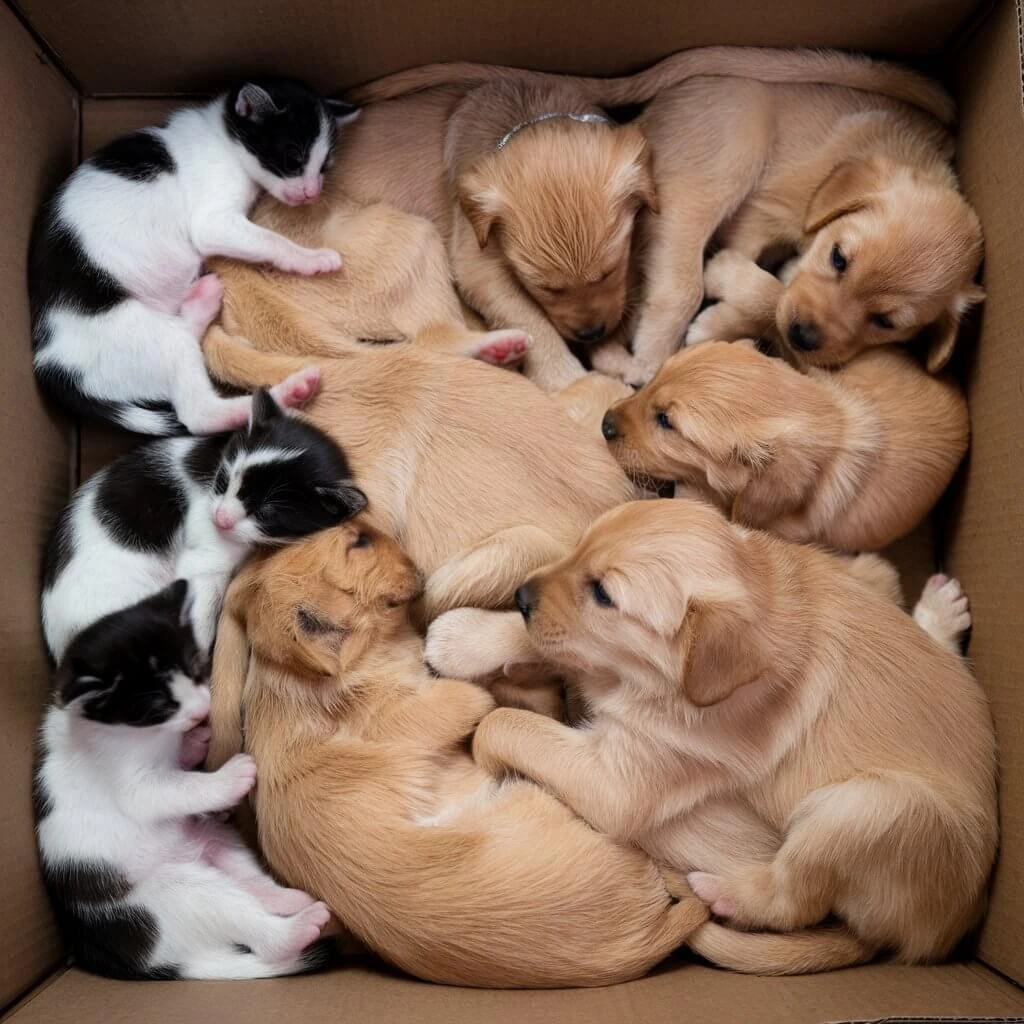
Newborn kittens, with their delicate bodies and gentle purring, are entirely dependent on their mother or caregiver for survival. From feeding to warmth and hygiene, they require careful attention to ensure they grow into healthy and independent cats. On the other hand, newborn puppies are equally dependent but often exhibit a different set of behaviors and developmental milestones that make them distinct from their feline counterparts.
For first-time pet owners, the differences between caring for kittens and puppies can be surprising. From their feeding routines to their socialization needs and hygiene habits, understanding these differences is crucial for providing the best care. Are kittens more independent than puppies? Do puppies require more hands-on training? How do you ensure that both grow up happy and healthy?
In this post, we’ll dive deep into the fascinating world of newborn kittens vs newborn puppies. We’ll explore their unique characteristics, care requirements, and key differences to help you confidently nurture these tiny furry friends. Whether you’re a devoted cat lover, a dog enthusiast, or someone torn between the two, this guide will equip you with everything you need to know about the early days of kittens and puppies.
Understanding the Unique Needs of Newborn Kittens vs Newborn Puppies
Physical Characteristics
Newborn kittens and puppies may seem similar at first glance—both are tiny, fragile, and adorable—but they have distinct physical traits that set them apart.
- Size and Weight: Newborn kittens typically weigh between 3-4 ounces at birth, while puppies can range widely in weight depending on the breed. Larger dog breeds may give birth to puppies weighing over a pound, whereas smaller breeds might have puppies closer in size to kittens.
- Fur and Insulation: Kittens are born with soft, fine fur that offers minimal insulation, making warmth essential for their survival. Puppies, especially those from breeds with thicker coats, may have slightly better natural insulation, but they are still unable to regulate their body temperature effectively in the early weeks.
- Eyes and Ears: Both kittens and puppies are born blind and deaf. Kittens usually open their eyes around 7-10 days, revealing their characteristic blue-gray hue, which may change as they mature. Puppies’ eyes open slightly later, around 10-14 days, and their hearing develops shortly afterward.
- Mobility: At birth, kittens and puppies are unable to walk and rely on their front limbs to scoot around their environment. Kittens tend to show signs of agility earlier than puppies, reflecting their future as climbers and hunters.
Understanding these physical differences can help caregivers tailor their approach to handling, feeding, and providing an environment that meets the specific needs of kittens or puppies.
Development Stages
The early developmental stages of newborn kittens vs newborn puppies reveal fascinating differences in how they grow and mature.
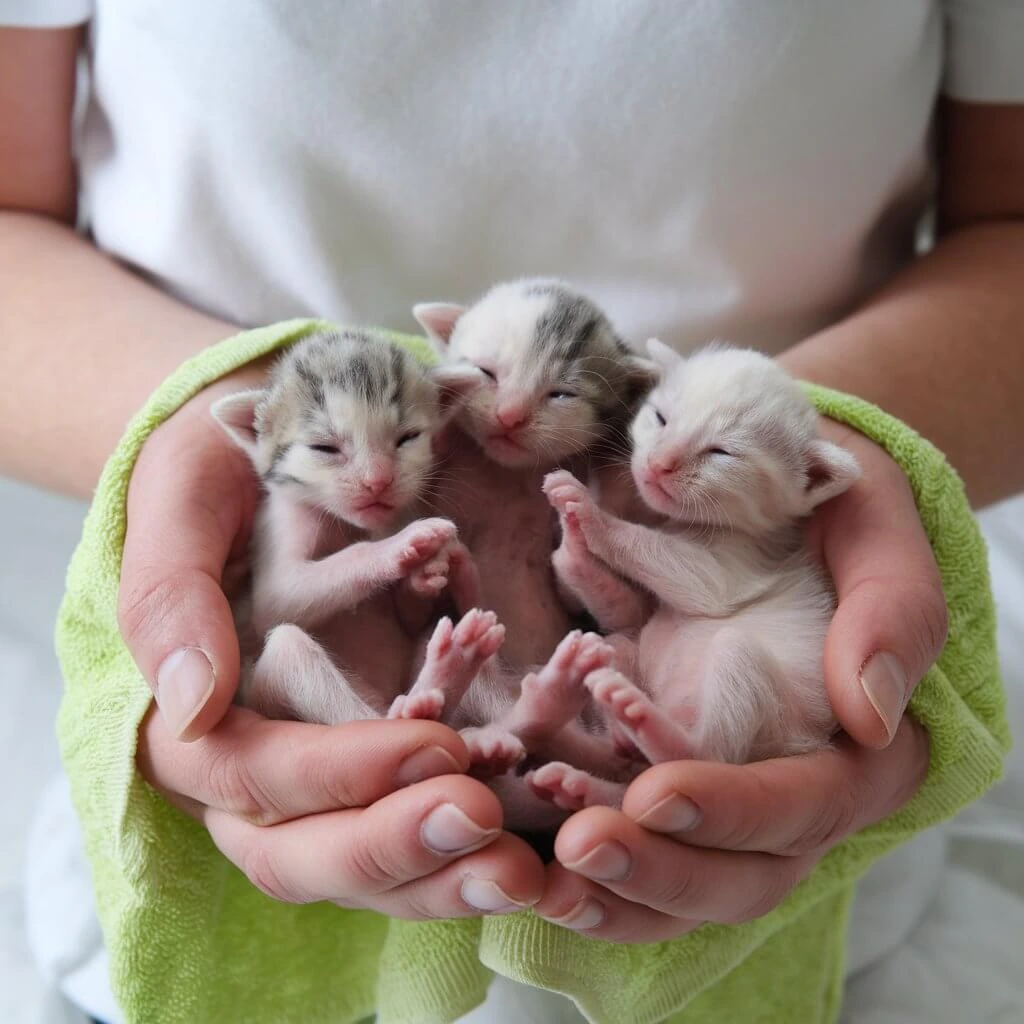
- Neonatal Stage (0-2 Weeks): During this stage, both kittens and puppies are completely reliant on their mother or caregiver. They spend a lot of time sleeping and feeding. Kittens often exhibit rapid growth during this period, doubling their birth weight in the first week. Puppies grow at a similar rate but tend to have a more robust appetite and require slightly larger meals.
- Transitional Stage (2-4 Weeks): Kittens begin to open their eyes and ears, taking their first wobbly steps by the third week. Puppies follow a similar pattern but may take longer to walk confidently. This stage marks the beginning of exploration, with kittens showing more independence and curiosity, while puppies often stick close to their littermates or caregivers.
- Socialization Stage (4-12 Weeks): During this critical period, both kittens and puppies begin to interact with their environment, littermates, and humans. Kittens start playing more aggressively, honing their hunting and climbing skills. Puppies, on the other hand, begin to learn pack dynamics, communication, and basic training commands. The experiences during this stage significantly influence their behavior and temperament as adults.
Being aware of these stages allows caregivers to provide the right type of care, stimulation, and socialization at the appropriate time, ensuring healthy development.
Behavioral Traits
newborn kittens vs newborn puppies display distinct behavioral traits even from a young age, reflecting their species’ unique instincts and evolutionary paths.
- Independence vs. Sociability: Kittens are naturally more independent than puppies. Even as newborns, they tend to explore their environment with a cautious curiosity. Puppies, however, thrive on social interaction and tend to bond strongly with their littermates and caregivers. This difference often influences how they respond to training and socialization efforts.
- Play Behavior: Kittens engage in play that mimics hunting behaviors, such as stalking, pouncing, and batting at objects. These activities help them develop the coordination and reflexes needed for adulthood. Puppies, on the other hand, engage in play that reflects their pack instincts, such as tugging, chasing, and mock fighting. This helps them learn social cues and establish boundaries.
- Communication: Newborn kittens primarily communicate through soft mews and purring, signaling their needs to their mother or caregiver. Puppies, however, tend to be more vocal, using a variety of whimpers, barks, and growls to express themselves. Their body language is also more dynamic, with tail wags and playful gestures being common even at a young age.
Understanding these behavioral traits helps caregivers provide the right type of stimulation and interaction to nurture the unique personality of each kitten or puppy.
Feeding Newborn Kittens vs. Puppies
Milk Replacer and Bottle Feeding
newborn kittens vs newborn puppies that are orphaned or not nursing well, milk replacer and bottle feeding are essential for their survival. Proper feeding techniques and the right nutrition can make a significant difference in their growth and development.
- Choosing the Right Milk Replacer:
Kittens and puppies have specific dietary needs that differ from those of other species, including humans. A high-quality milk replacer formulated specifically for kittens or puppies is essential. These replacers mimic the nutritional composition of their mother’s milk, providing essential proteins, fats, vitamins, and minerals. Avoid using cow’s milk or generic substitutes, as these can cause digestive upset or fail to meet their nutritional needs. - Feeding Equipment:
Bottle feeding requires specialized equipment, including small, soft-nippled bottles or syringes for precise feeding. Make sure to sterilize the equipment before each use to prevent infections. Select a nipple size that fits comfortably in the newborn’s mouth and allows milk to flow steadily but not too quickly. - Feeding Technique:
Hold the kitten or puppy in an upright, natural position while feeding to prevent aspiration (milk entering their lungs). Avoid feeding them while they are lying on their backs, as this can lead to choking. Squeeze the bottle gently to ensure a slow and steady flow of milk, allowing the newborn to suckle naturally. Be patient, as it may take time for them to latch properly.
- Monitoring Intake:
Each kitten or puppy’s appetite may vary, but it’s crucial to ensure they are consuming enough to grow steadily. Monitor their weight daily to confirm they are gaining approximately 5-10% of their body weight each day.
Feeding Schedules
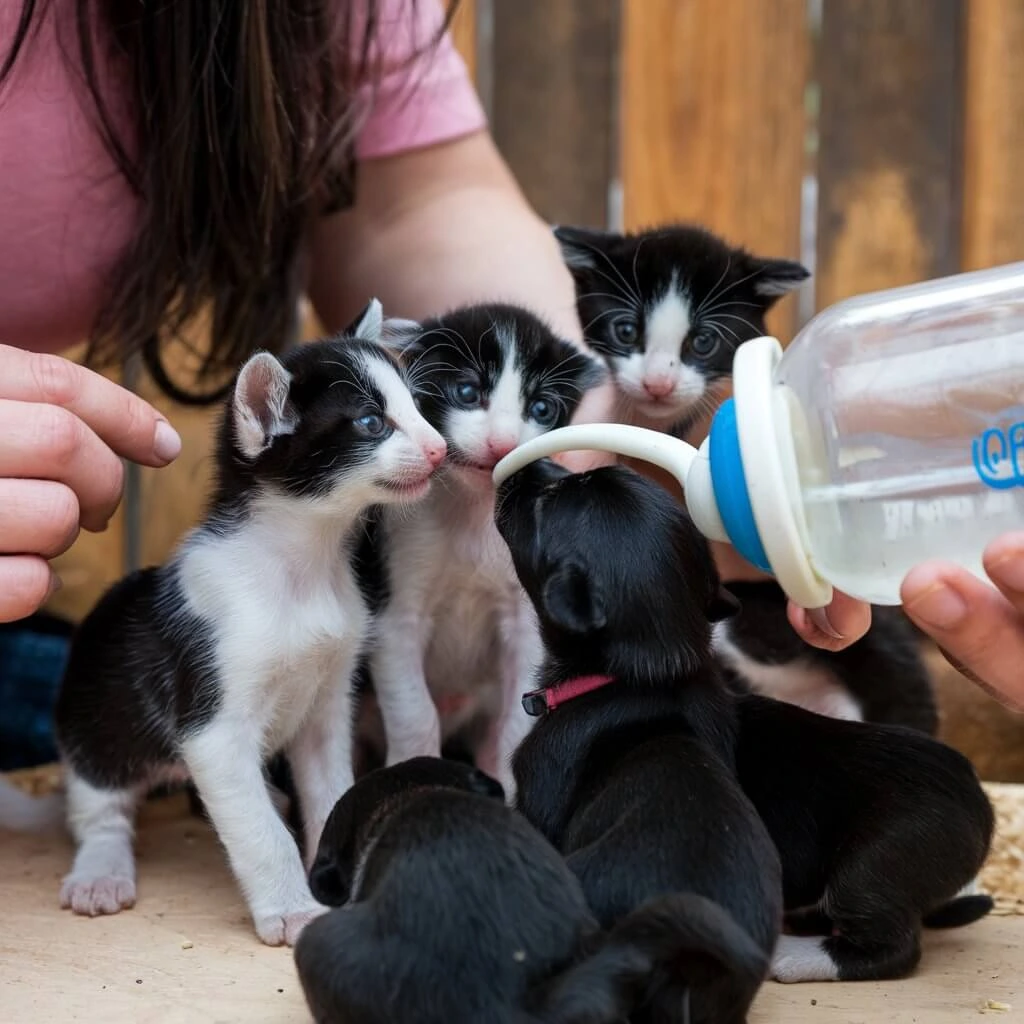
Newborn kittens and puppies have small stomachs and high energy requirements, necessitating frequent feedings during the first few weeks of life.
- First Week:
During the neonatal stage, kittens and puppies need to be fed every 2-3 hours around the clock. This includes nighttime feedings, as their small bodies cannot store enough energy to sustain them for long periods. - Second Week:
As they grow, the interval between feedings can be extended slightly to every 3-4 hours. By this time, they should begin drinking slightly larger quantities during each feeding. - Third Week and Beyond:
By the third week, their feeding intervals can be increased to every 4-6 hours. This stage also marks the beginning of their preparation for weaning, as they become more curious and active. - Signs of Adequate Feeding:
Well-fed newborns will sleep soundly between feedings and exhibit steady weight gain. Watch for signs of hunger, such as restlessness, crying, or rooting behavior (searching for a nipple). Adjust feeding schedules as needed to accommodate their growth.
Transition to Solid Food
Weaning is a critical milestone in the lives of newborn kittens and puppies. The transition from milk to solid food typically begins around 4-5 weeks of age and requires a gradual approach to ensure proper digestion and acceptance of new textures.
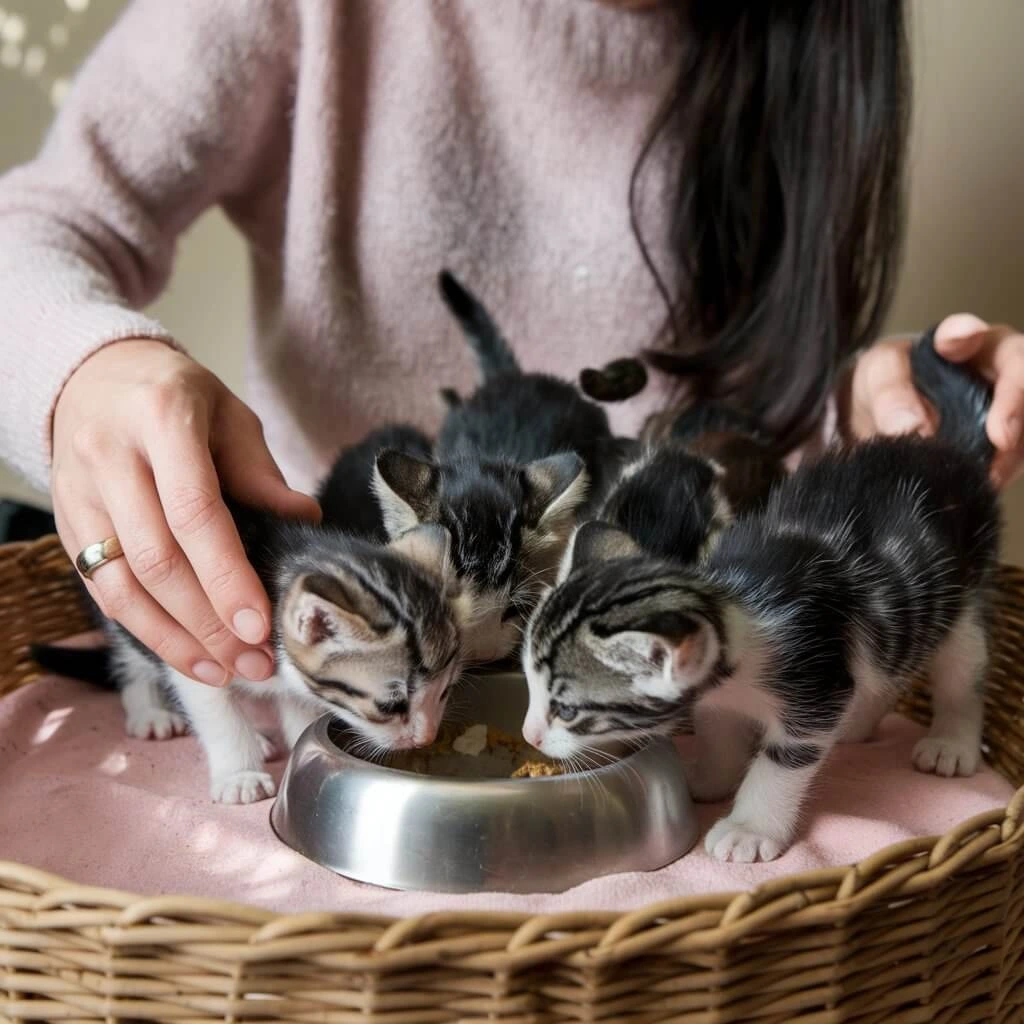
- Introducing Solid Food:
Start by preparing a gruel made of high-quality kitten or puppy food mixed with warm water or milk replacer. The consistency should be soft and mushy, making it easier for the newborns to lap up the food. Offer the gruel in a shallow dish and guide them to it by gently placing a small amount near their mouths. - Encouraging Exploration:
Some kittens and puppies may take to solid food immediately, while others may need more encouragement. Patience is key—allow them to explore the food at their own pace. Avoid forcing them to eat, as this can create negative associations with the new diet. - Gradually Reducing Liquid:
Over the next couple of weeks, gradually decrease the amount of liquid added to the gruel, allowing the food to become more solid. By 7-8 weeks, most kittens and puppies can eat entirely solid food, provided it is appropriate for their age and nutritional needs.
- Monitoring During Weaning:
Watch for any signs of digestive upset, such as diarrhea or vomiting, during the transition to solid food. If issues arise, slow the weaning process and consult a veterinarian if necessary. Ensure that fresh water is always available to help them stay hydrated as they adjust to their new diet.
Keeping Newborn Pets Warm and Comfortable
Importance of Warmth
Newborn kittens and puppies are unable to regulate their body temperature for the first few weeks of life, making warmth a critical component of their care. Without sufficient warmth, they risk hypothermia, which can quickly become life-threatening.
- Why Warmth Matters:
In the early weeks of life, kittens and puppies rely entirely on external heat sources to maintain their body temperature. Their underdeveloped thermoregulation systems make them highly sensitive to environmental changes, and even slight drops in temperature can weaken their immune systems, slow their metabolism, and interfere with digestion. - Ideal Temperature Ranges:
For the first week, the environment should be kept between 85-90°F (29-32°C). This can be gradually reduced as they grow older—around 80°F (27°C) during the second week and 75°F (24°C) by the fourth week. Use a thermometer to monitor the temperature of their living area and adjust as necessary. - Heat Sources:
Heating pads, heat lamps, and hot water bottles (wrapped in a towel to prevent burns) are effective ways to provide consistent warmth. For larger litters, ensure the heat source is evenly distributed, allowing them to move closer or further away as needed. Never place a heating device directly on the newborns, as their delicate skin can burn easily. - Signs of Hypothermia:
Symptoms of hypothermia include cold, pale skin, lethargy, crying, and refusal to eat. If you notice these signs, warm the kitten or puppy gradually—never rapidly—as sudden temperature changes can cause shock.
Bedding and Nesting Options
Providing the right bedding and nesting environment is crucial for keeping newborn kittens and puppies safe, warm, and comfortable.
- Materials for Bedding:
Use soft, insulating materials such as fleece blankets, towels, or specialized pet bedding. These materials retain warmth while being gentle on the delicate skin of newborns. Avoid materials that can snag on claws or pose a choking hazard, such as loose threads or synthetic fibers. - Layering for Warmth:
Create layers in the bedding to provide additional insulation. A base layer of waterproof material can protect against accidents, while soft layers on top offer comfort and warmth. Ensure bedding is thick enough to keep the newborns off cold surfaces, especially if they are on tile or hardwood floors. - Size and Shape of the Nest:
The nest should be large enough for the litter to move around comfortably but small enough to retain heat. Nesting boxes, crates, or playpens with high sides help contain warmth and provide a sense of security. For kittens, consider an open-top area to allow the mother easy access. - Hygiene:
Replace bedding daily or as needed to maintain cleanliness. Newborns are prone to accidents, and soiled bedding can lead to infections or attract parasites. Wash reusable bedding materials with mild, pet-safe detergent and ensure they are thoroughly dried before reuse.
Monitoring Their Environment
A stable, safe, and clean environment is essential for the health and development of newborn kittens and puppies. Regular monitoring ensures they remain comfortable and free from potential hazards.
- Temperature and Humidity:
Use a room thermometer to maintain the recommended temperature ranges, and a hygrometer to monitor humidity levels. Low humidity can cause dehydration, while excessive humidity can lead to respiratory issues. Aim for a humidity level between 50-60%. - Quiet and Calm Atmosphere:
Make the place calm and easy for everyone. Loud noises, bright lights, or frequent disturbances can cause stress to newborns, affecting their development. Place their nest in a quiet corner of your home, away from high-traffic areas. - Safety Checks:
Ensure the area is free from hazards such as electrical cords, small objects they could swallow, or sharp edges. If using a heat lamp, secure it firmly to prevent it from falling into the nest. Supervise interactions with other pets or children to avoid accidental injuries. - Daily Observation:
Regularly observe the litter for signs of distress or discomfort. Excessive crying, huddling together for warmth, or moving away from heat sources can indicate environmental issues. Check for any visible signs of illness, such as discharge from the eyes or nose, or changes in appetite or activity levels. - Ventilation and Fresh Air:
Ensure the area is well-ventilated to maintain air quality, but avoid placing newborns in direct drafts. Good ventilation prevents the buildup of odors and reduces the risk of respiratory problems caused by stale air or excessive moisture.
Ensuring Proper Hygiene and Health Care
Cleaning and Grooming
Keeping newborn kittens and puppies clean is essential for their health and comfort, but their delicate bodies require gentle handling and specific techniques to avoid harm.
1. Cleaning Newborn Kittens and Puppies
Newborns cannot clean themselves, and their mothers typically perform this task by licking them. If the mother is absent or needs assistance, caregivers should step in. Use a soft, damp cloth or cotton ball soaked in warm water to mimic a mother’s licking. Gently wipe their bodies, paying special attention to areas like their face, belly, and paws. Avoid using soaps or shampoos unless advised by a vet, as harsh chemicals can irritate their sensitive skin.
2. Stimulating Elimination
For the first few weeks, newborn kittens and puppies cannot urinate or defecate on their own. Mothers naturally stimulate elimination by licking their genital and anal areas. If you’re caring for orphaned newborns, you must replicate this by gently rubbing the area with a warm, damp cotton ball after feeding.
3. Grooming Tools and Techniques
While grooming isn’t a priority in the earliest days, introducing basic tools can prepare kittens and puppies for grooming as they grow. Use a soft-bristle brush or a pet grooming mitt to remove loose fur and stimulate blood circulation. Regular gentle grooming also helps foster bonding and keeps their coat in healthy condition.
Veterinary Care
Newborn kittens vs newborn puppies are highly vulnerable to illness, and regular veterinary care is crucial to ensure they thrive during these formative weeks.
1. First Veterinary Check-Up
A vet visit within the first week of life is essential, especially for orphaned or at-risk newborns. The vet will assess their overall health, check for congenital abnormalities, and provide guidance on their care. Puppies and kittens from unvaccinated mothers should be monitored closely for infections.
2. Vaccination Schedules
Vaccinations protect against life-threatening diseases like parvovirus in puppies and feline panleukopenia in kittens. The first round of vaccines is typically given around 6–8 weeks of age, with booster shots following every few weeks until they are fully protected. Work with your vet to establish a vaccination timeline tailored to your pet’s needs.
3. Deworming and Parasite Control
Parasites like worms and fleas can quickly deplete a newborn’s energy and nutrition. Most kittens and puppies are born with or acquire intestinal worms, making deworming essential. A vet will recommend safe deworming medications, usually starting at 2–3 weeks of age and continuing at regular intervals. Preventing fleas and mites also helps reduce discomfort and the risk of disease transmission.
Spotting Health Issues
Recognizing early signs of illness in newborn kittens and puppies can mean the difference between recovery and serious complications.
1. Common Health Problems
- Hypothermia: Newborns can’t regulate their body temperature. If they feel cold, are lethargic, or refuse to nurse, warm them immediately and consult a vet.
- Hypoglycemia: Low blood sugar is a common risk in newborns. Symptoms include weakness, trembling, or seizures. Feeding them promptly and ensuring a steady intake of nutrients is crucial.
- Infections: Look for swelling, redness, or discharge in the eyes, ears, or umbilical area. These may indicate infections that require medical attention.
2. Signs to Watch For
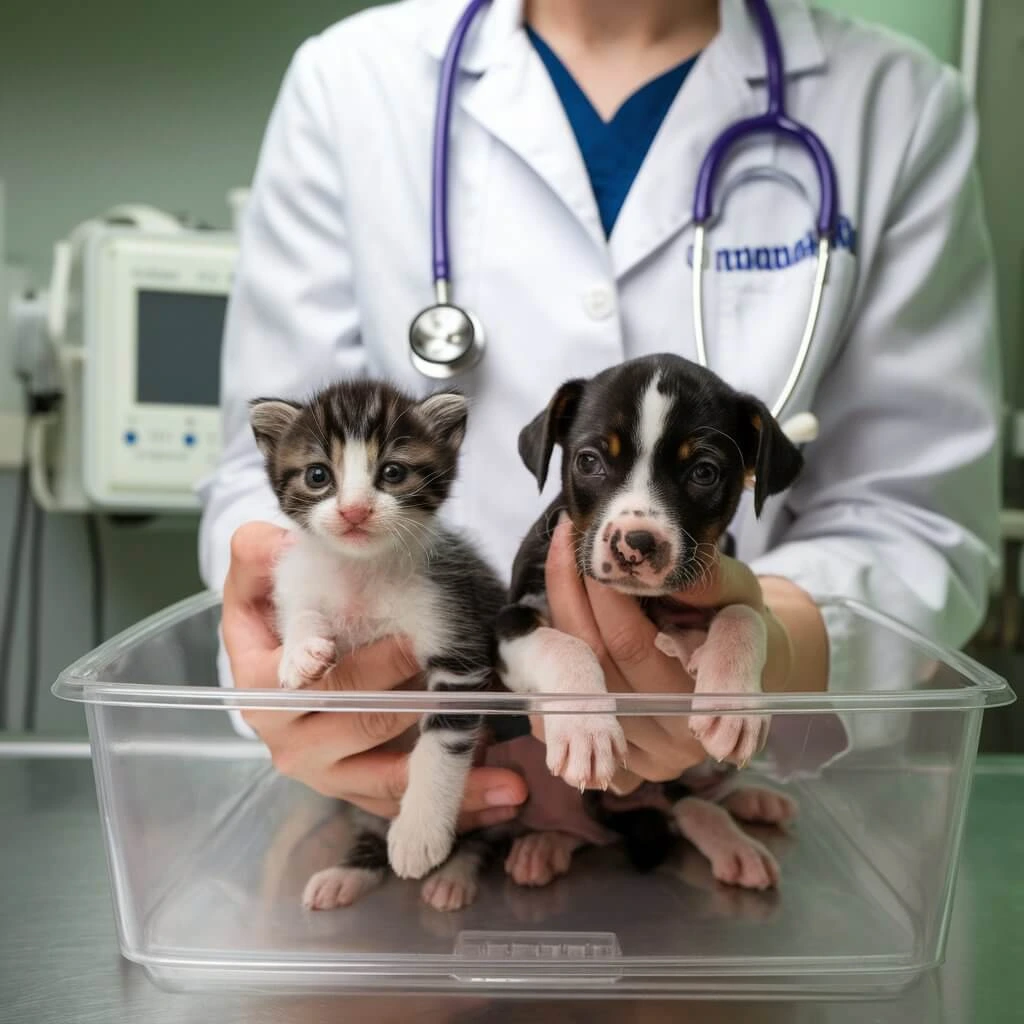
- Lack of appetite or refusal to nurse.
- Persistent crying, which may signal discomfort or illness.
- Lethargy, weakness, or inability to move normally.
- Abnormal stool color, consistency, or frequency.
- Breathing difficulties, such as wheezing or gasping.
3. When to Seek Veterinary Help
Act promptly if you notice any of the above signs. Newborns’ health can decline rapidly, so consulting a vet at the earliest sign of trouble ensures the best outcome. Keep a log of their feeding, elimination, and behavior to provide your vet with detailed information.
By prioritizing hygiene and health care, you can create a safe, nurturing environment where newborn kittens and puppies can grow and thrive. Regular cleaning, early veterinary care, and vigilant monitoring of their health will lay the foundation for a happy and healthy future.
Socialization and Early Training Tips
Socializing with Humans and Other Pets
Proper socialization during the early weeks of life helps kittens and puppies grow into confident, well-adjusted adults. Introducing them to humans, other animals, and various environments during this critical period lays the groundwork for positive interactions throughout their lives.
1. Introducing Newborns to Humans
Start by gently handling kittens and puppies for short periods each day. Use a calm voice, slow movements, and soft touches to build trust. Gradually increase interaction time as they grow. Allow family members and close friends to interact with the newborns, ensuring everyone follows safe handling practices.
2. Gradual Introduction to Other Pets
If you have other pets, introduce them slowly and under supervision. Keep initial meetings brief and in a neutral space to prevent territorial behavior. For puppies, leash introductions can help control the situation. With kittens, use a carrier or barrier to allow visual and olfactory exploration without direct contact. Always reward positive interactions with treats and praise.
3. Exposing Newborns to Different Environments
Although newborns shouldn’t venture outdoors until they’re vaccinated, exposing them to household sounds, objects, and mild stimuli is essential. Let them hear the vacuum cleaner from a distance, experience different textures underfoot, and see various objects to reduce fear of the unfamiliar as they grow.
Litter Training vs. Potty Training
Teaching newborn kittens and puppies where to eliminate is a crucial part of their development. While the methods differ, patience and consistency are key to successful training.
1. Litter Training for Kittens
Kittens instinctively use litter boxes, making training relatively easy.
- Setting Up the Litter Box: Choose a shallow box with unscented, non-clumping litter to make it accessible and safe. Put the box in a calm place where it is easy to reach.
- Encouraging Usage: After meals or naps, gently place kittens in the litter box and use a soft, sweeping motion to mimic digging. This helps them associate the box with elimination.
- Cleaning and Maintenance: Keep the litter box clean to encourage regular use. Scoop waste daily and replace litter as needed to prevent odors and discomfort.
2. Potty Training for Puppies
Puppies require more structured potty training since they don’t naturally eliminate in designated spots.
- Establishing a Routine: Take puppies to their designated potty spot immediately after waking, eating, or playing. Consistency reinforces the habit.
- Using Positive Reinforcement: Reward successful potty trips with praise, treats, or a favorite toy. Avoid punishment for accidents, as this can create fear or confusion.
- Crate Training: If using a crate, make it a cozy and safe space. Puppies are less likely to eliminate in their sleeping area, helping reinforce control.
Encouraging Positive Behavior
Building good habits and behaviors early on ensures kittens and puppies grow into well-mannered pets.
1. Gentle Handling Techniques
Handle newborns carefully to foster trust and prevent fear. Support their body fully and avoid sudden movements. Speak softly and avoid loud noises to create a calm environment.
2. Providing Appropriate Toys and Activities
Introduce age-appropriate toys to encourage play and stimulate development.
- Kittens: Toys that mimic prey, such as feathers or balls, satisfy their natural hunting instincts.
- Puppies: Chew toys help with teething and prevent destructive chewing on household items.
3. Setting Boundaries Early
Teach kittens and puppies what is acceptable by redirecting unwanted behaviors.
- For Kittens: If a kitten scratches furniture, redirect them to a scratching post.
- For Puppies: If a puppy nips during play, stop the interaction briefly to show that biting ends fun.
4. Encouraging Independence
While bonding is vital, teaching kittens and puppies to entertain themselves fosters independence. Gradually increase time spent apart to prevent separation anxiety.
5. Using Rewards to Reinforce Behavior
Positive reinforcement is the most effective way to shape good behavior. Give treats, words of praise, or playtime for good actions. This helps encourage them to do those actions again. As time goes on, they will learn that behaving well leads to good results.
By socializing early, training with consistency, and encouraging positive behavior, you’ll help your newborn kittens and puppies grow into confident, happy, and well-behaved companions. These early efforts will set the stage for a lifelong bond built on trust and mutual understanding.
to learn more about pets care and puppies “pawpits official
Conclusion
Caring for newborn kittens and puppies is a journey filled with joy, responsibility, and countless heartwarming moments. While both newborn kittens and newborn puppies bring unique challenges and rewards, understanding their specific needs ensures they grow into healthy, happy companions. From feeding schedules to creating a warm and comfortable environment, every aspect of their care requires patience and dedication.
Newborn kittens, with their delicate fragility and independent nature, need extra attention to their warmth and hygiene, while newborn puppies thrive on early bonding and socialization. By recognizing the differences in their development stages and behavioral traits, you can provide the tailored care they deserve. Whether you’re feeding, grooming, or transitioning them to solid food, being informed and attentive is key to raising both newborn kittens and newborn puppies successfully.
Don’t forget the importance of early veterinary care and spotting health issues. Vaccinations, deworming, and regular check-ups are critical for ensuring your furry friends’ well-being. Additionally, fostering socialization and training from an early age—whether it’s litter training for newborn kittens or potty training for newborn puppies—will set them up for a well-adjusted life.
Cherish these precious moments of nurturing your tiny furry companions. The bond you build during these formative weeks will last a lifetime. Remember, whether you’re caring for newborn kittens or newborn puppies, the love and effort you put in will be returned tenfold in their affection and loyalty.
We’d love to hear your stories and experiences with newborn kittens vs newborn puppies! Have tips, questions, or heartwarming tales to share? Please share your thoughts in the comments below and join the discussion!. Together, let’s celebrate the joy of raising these adorable bundles of fur!
Learn more About Baby Kittens Here.
Learn more about puppies Here.
Find Some Good Stuff for your Tiny pet on Pet MD Official.
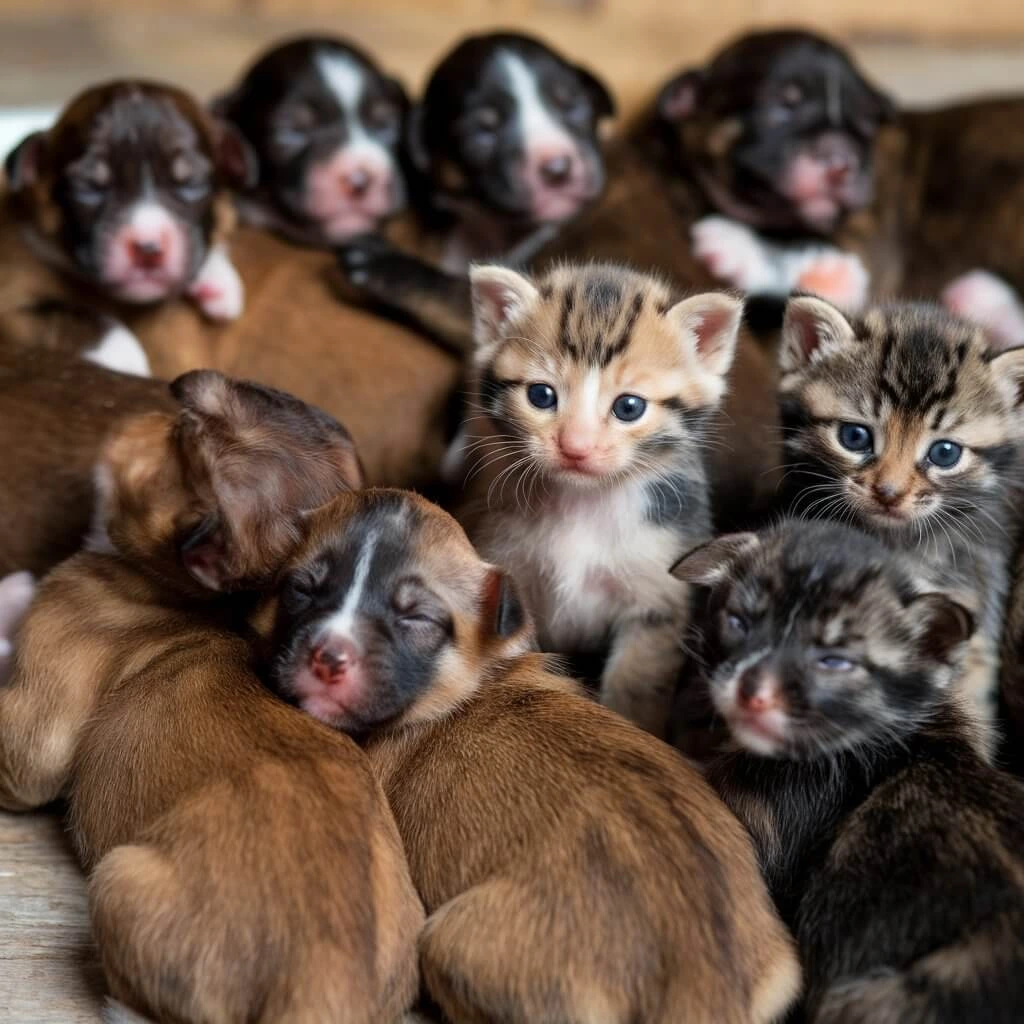
2 thoughts on “Newborn Kittens vs Puppies: How to Care for Your Tiny Furry Friends”
Comments are closed.